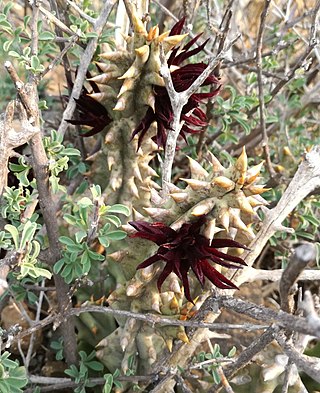
The Asclepiadoideae are a subfamily of plants in the family Apocynaceae. Formerly, they were treated as a separate family under the name Asclepiadaceae, e.g. by APG II, and known as the milkweed family.

The Aizoaceae, or fig-marigold family, is a large family of dicotyledonous flowering plants containing 135 genera and about 1800 species. They are commonly known as ice plants or carpet weeds. They are often called vygies in South Africa and New Zealand. Highly succulent species that resemble stones are sometimes called mesembs.

The genera of plants within the tribe Stapelieae are all to varying degrees stem succulents. Many of the species resemble cacti, though are not closely related, as an example of convergent evolution. The stems are often angular, mostly four-angled in cross-section, but in some species there are six or more, with some species of Hoodia having more than thirty angles. In size they vary from less than 2.5 cm/1" in length to over 2 m/6" tall. The leaves are in most species reduced to rudiments, sometimes hardened and thorn-like, arranged on bumps or tubercles on the angles. Some species, however, still have recognisable leaves, most notably the Indian species Frerea indica, and some members of Tridentea. Stapeliads are most abundant in warm, dry climates. In Africa, there are two separate regions where Stapeliads have most diversified: northeast Africa, and Southern Africa. Several species are endemic to the small island of Socotra off the Horn of Africa. The Arabian Peninsula, and most specifically the country of Yemen, contain another concentration of species. Several more are found in the drier parts of Pakistan, Afghanistan, India, Nepal, and Myanmar. A single species, Caralluma europea is found in Europe, in the very southern part of the Iberian peninsula and in the island of Lampedusa. Stapeliads are often regarded as a climax group within the family because of their often structurally complex flowers. Certain aspects of these reproductive parts mirror the pollination systems in the Orchid family and represent a case of parallel evolution though both groups are quite unrelated and have developed similar, though not identical means to achieve the ultimate goal of pollination and therefore reproduction. Most stapeliads use flies as pollinators, that are attracted to odours resembling dung or rotting meat, emanating from the flowers. Many of the flowers also bear some physical resemblance to rotting animal carcasses, leading to their popular name of Carrion Flowers. However, not all stapeliads smell bad, or attract flies. Some species use beetles, bees, wasps, butterflies or moths as pollinators. Stapeliad flowers range in size from mere millimetres in species of Echidnopsis and Pseudolithos to those of Stapelia gigantea that can reach 40 cm/16" in diameter, and are some the largest of flowers to be found on any species of succulent.

Stapelia is a genus of low-growing, spineless, stem succulent plants, predominantly from South Africa with a few from other parts of Africa. Several Asian and Latin American species were formerly included but they have all now been transferred to other genera. The flowers of certain species, most notably Stapelia gigantea, can reach 41 cm (16 inches) in diameter when fully open. Most Stapelia flowers are visibly hairy and generate the odor of rotten flesh when they bloom.

The genus Huernia consists of perennial, stem succulents from Eastern and Southern Africa and Arabia, first described as a genus in 1810.

Gasteria is a genus of succulent plants, native to South Africa and the far south-west corner of Namibia.

Mesembryanthemum is a genus of flowering plants in the family Aizoaceae, indigenous to southern Africa. As with many members of that family, it is characterized by long-lasting flower heads. Flowers of Mesembryanthemum protect their gametes from night-time dews or frosts but open in sunlight. There is an obvious evolutionary advantage to doing this; where sun, dew, frost, wind or predators are likely to damage exposed reproductive organs, closing may be advantageous during times when flowers are unlikely to attract pollinators.

Duvalia is a succulent plant genus in the subfamily Asclepiadoideae, in the family Apocynaceae (dogbane).

The genus Quaqua falls within the tribe of plants known collectively as stapeliads. All stapeliads, including Quaqua, are Old World stem succulents.

AnacampserosL. is a genus comprising about a hundred species of small perennial succulent plants native to Southern Africa, Ethiopia and Latin America. The botanical name Anacampseros is an ancient one for herbs supposed to restore lost love.

Stapelianthus is a genus of flowering plants in the family Apocynaceae, first described as a genus in 1933. The entire genus is endemic to Madagascar and is concentrated in the far south of the island.

Paranomus is a genus of 18 species of flowering plants, commonly known as "sceptres", in the protea family. It is endemic to the Cape Floristic Region of South Africa.

Tromotriche is a genus of plant in family Apocynaceae. It is native to southern Africa.

Stapeliopsis is a genus of succulent plants in the family Apocynaceae, native to southern Africa.

Piaranthus is a succulent plant genus in the subfamily Asclepiadoideae, in the family Apocynaceae.

Orbea is a genus of flowering plants of the family Apocynaceae, first described as a genus in 1812. It is native to Africa and the Arabian Peninsula.
Pectinaria is a genus of plants in the family Apocynaceae, first described as a genus in 1819. The entire genus is endemic to South Africa.

Stapelia hirsuta, common name starfish flower or carrion plant, is a species of flowering plant belonging to the family Apocynaceae.


















